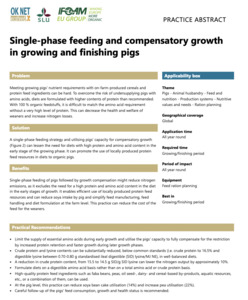{Tool} Single-phase feeding and compensatory growth in growing and finishing pigs (OK-Net Ecofeed Practice Abstract). Creator(s): Åkerfeldt, Magdalena. Issuing Organisation(s): SLU - Swedish University of Agricultural Sciences. OK-Net Ecofeed Practice Abstract, no. 024. (2020)
|
PDF
- English
(Single-phase feeding and compensatory growth in growing and finishing pigs)
498kB | |
![[thumbnail of Bildschirmfoto 2024-04-16 um 11.45.18.png]](/37512/3.hassmallThumbnailVersion/Bildschirmfoto%202024-04-16%20um%2011.45.18.png)  Preview |
Image (PNG)
- Cover Image
- English
626kB |
Document available online at: https://orgprints.org/37512
Summary in the original language of the document
• Limit the supply of essential amino acids during early growth and utilise the pigs’ capacity to fully compensate for the restriction by increased protein retention and faster growth during later growth phases.
• Crude protein and lysine contents can be substantially reduced, below common standards (i.e. crude protein to 16.5% and digestible lysine between 0.70-0.80 g standardised ileal digestible (SID) lysine/MJ NE), in well-balanced diets.
• A reduction in crude protein content, from 15.5 to 14.5 g SID/g SID lysine can lower the nitrogen output by approximately 10%.
• Formulate diets on a digestible amino acid basis rather than on a total amino acid or crude protein basis.
• High-quality protein feed ingredients such as faba beans, peas, oil seed-, dairy- and cereal-based by-products, aquatic resources, etc., or a combination of them, can be used.
• At the pig level, this practice can reduce soya bean cake utilisation (14%) and increase pea utilisation (22%).
• Careful follow-up of the pigs' feed consumption, growth and health status is recommended.
| EPrint Type: | Practice tool |
|---|---|
| What problem does the tool address?: | Meeting growing pigs’ nutrient requirements with on-farm-produced cereals and protein feed ingredients can be hard. To overcome the risk of undersupplying pigs with amino acids, diets are formulated with higher contents of protein than recommended. With 100 % organic feedstuffs, it is difficult to match the amino acid requirement without a very high level of protein. This can decrease the health and welfare of weaners and increase nitrogen losses. |
| What solution does the tool offer?: | A single-phase feeding strategy and utilising pigs’ capacity for compensatory growth (Figure 2) can lessen the need for diets with high protein and amino acid content in the early stage of the growing phase. It can promote the use of locally produced protein feed resources in diets to organic pigs. |
| Country: | Sweden |
| Type of Practice Tool: | Practice abstracts |
| Keywords: | pigs, feeding and ration planning, nutrient requirements, animal husbandry |
| Agrovoc keywords: | Language Value URI English swine http://aims.fao.org/aos/agrovoc/c_7555 English feeding http://aims.fao.org/aos/agrovoc/c_2838 English rations http://aims.fao.org/aos/agrovoc/c_6461 English nutritional requirements http://aims.fao.org/aos/agrovoc/c_5277 English animal husbandry http://aims.fao.org/aos/agrovoc/c_8532 |
| Subjects: | Animal husbandry > Feeding and growth Animal husbandry > Production systems > Pigs |
| Research affiliation: | European Union > Horizon 2020 > OK-Net EcoFeed European Union > Horizon 2020 > OK-Net EcoFeed > OK-Net Ecofeed Tools Sweden > Swedish University of Agricultural Sciences (SLU) > Department of Animal Nutrition and Management European Union > Organic Farm Knowledge |
| Horizon Europe or H2020 Grant Agreement Number: | 773911 |
| Related Links: | https://orgprints.org/37512, https://www.slu.se, https://organic-farmknowledge.org/tool/37512, https://www.facebook.com/organicfarmknowledge/photos/a.341364110046066/630988224416985, https://twitter.com/farm_knowledge/status/1239588483179712513 |
| Project ID: | ofk |
| Deposited By: | Forschungsinstitut für biologischen Landbau, FiBL |
| ID Code: | 37512 |
| Deposited On: | 09 Mar 2020 11:15 |
| Last Modified: | 02 May 2024 10:31 |
| Document Language: | English |
| Status: | Published |
Repository Staff Only: item control page

 Download Statistics
Download Statistics Download Statistics
Download Statistics
